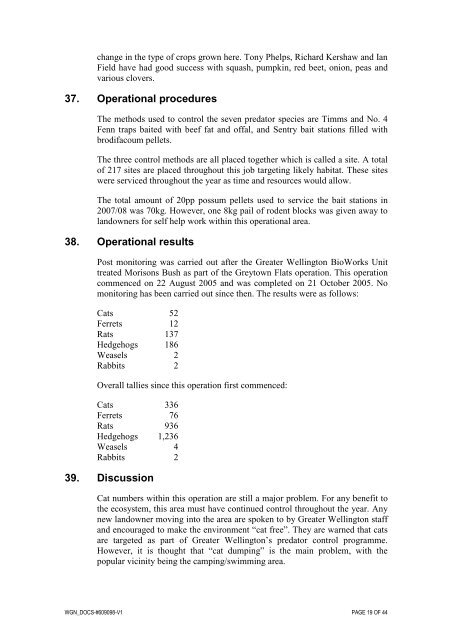Wairarapa Key Native Ecosystem Management Areas - Greater ...
Wairarapa Key Native Ecosystem Management Areas - Greater ...
Wairarapa Key Native Ecosystem Management Areas - Greater ...
Create successful ePaper yourself
Turn your PDF publications into a flip-book with our unique Google optimized e-Paper software.
change in the type of crops grown here. Tony Phelps, Richard Kershaw and Ian<br />
Field have had good success with squash, pumpkin, red beet, onion, peas and<br />
various clovers.<br />
37. Operational procedures<br />
The methods used to control the seven predator species are Timms and No. 4<br />
Fenn traps baited with beef fat and offal, and Sentry bait stations filled with<br />
brodifacoum pellets.<br />
The three control methods are all placed together which is called a site. A total<br />
of 217 sites are placed throughout this job targeting likely habitat. These sites<br />
were serviced throughout the year as time and resources would allow.<br />
The total amount of 20pp possum pellets used to service the bait stations in<br />
2007/08 was 70kg. However, one 8kg pail of rodent blocks was given away to<br />
landowners for self help work within this operational area.<br />
38. Operational results<br />
Post monitoring was carried out after the <strong>Greater</strong> Wellington BioWorks Unit<br />
treated Morisons Bush as part of the Greytown Flats operation. This operation<br />
commenced on 22 August 2005 and was completed on 21 October 2005. No<br />
monitoring has been carried out since then. The results were as follows:<br />
Cats 52<br />
Ferrets 12<br />
Rats 137<br />
Hedgehogs 186<br />
Weasels 2<br />
Rabbits 2<br />
Overall tallies since this operation first commenced:<br />
Cats 336<br />
Ferrets 76<br />
Rats 936<br />
Hedgehogs 1,236<br />
Weasels 4<br />
Rabbits 2<br />
39. Discussion<br />
Cat numbers within this operation are still a major problem. For any benefit to<br />
the ecosystem, this area must have continued control throughout the year. Any<br />
new landowner moving into the area are spoken to by <strong>Greater</strong> Wellington staff<br />
and encouraged to make the environment “cat free”. They are warned that cats<br />
are targeted as part of <strong>Greater</strong> Wellington’s predator control programme.<br />
However, it is thought that “cat dumping” is the main problem, with the<br />
popular vicinity being the camping/swimming area.<br />
WGN_DOCS-#609098-V1 PAGE 19 OF 44
















